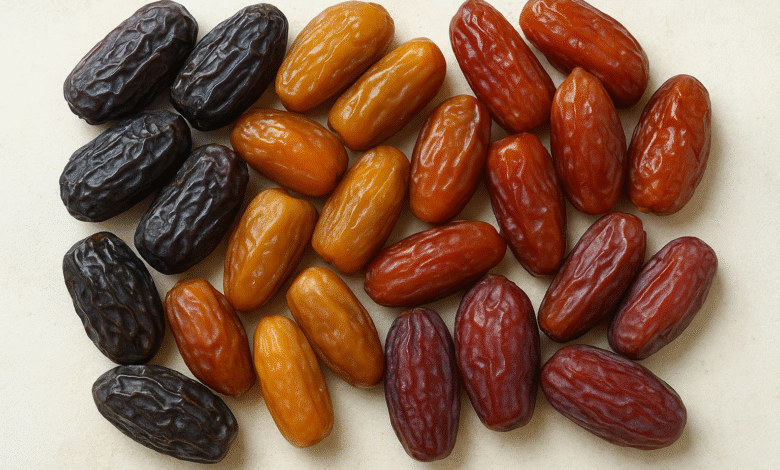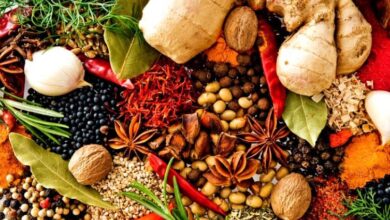The World of Dates: Types, History, Nutrition, and Cultural Significance
Discover the Fruit that Defines Middle Eastern Culture and Cuisine

1. Introduction to Dates
Dates are among the oldest cultivated fruits in the world, cherished not only for their natural sweetness but also for their cultural, nutritional, and medicinal value. They come from the date palm tree (Phoenix dactylifera), which thrives in hot, arid climates such as the Middle East, North Africa, and parts of South Asia. For thousands of years, dates have been a staple food in desert regions where few other crops could survive.
A single date fruit is small yet nutrient-dense, packed with natural sugars, fiber, vitamins, and minerals. Their flavor profile ranges from rich caramel-like sweetness to mild nutty notes, depending on the variety and ripeness. They can be eaten fresh, semi-dried, or fully dried, making them highly versatile. Beyond their role as a snack, dates are used in desserts, drinks, baking, and even savory dishes.
Today, there are over 200 varieties of dates, though only a handful are internationally recognized. Each variety differs in size, sweetness, color, and texture. For example, the Medjool is large and juicy, often called the “king of dates,” while the Deglet Noor is semi-dry and ideal for baking.
This article explores the fascinating journey of dates—from their historical roots to their many varieties, health benefits, and cultural significance—highlighting why this ancient fruit remains relevant in the modern diet.
2. History and Cultivation of Dates
The story of the date palm stretches back more than 5,000 years. Archaeological evidence shows that date palms were cultivated in Mesopotamia (modern-day Iraq) as early as 3000 BCE. Ancient Egyptians also revered dates, often depicting them in hieroglyphics and offering them during religious ceremonies.
The fruit spread through trade routes, becoming essential in regions across the Middle East, North Africa, and South Asia. Arab traders later introduced dates to Spain, and Spanish missionaries carried them to the Americas, particularly California and Mexico, in the 18th century. Today, major producers include Saudi Arabia, Iran, Iraq, Algeria, Egypt, the United Arab Emirates, and California (USA).
Date palm trees are remarkably resilient, thriving in harsh desert conditions. They require hot, dry climates and can withstand long droughts thanks to their deep root systems. A mature tree can live for over 100 years and produce hundreds of pounds of fruit annually.
The fruit develops in four main stages:
- Kimri – unripe, green, bitter.
- Khalal – crunchy, yellow or red, edible but astringent.
- Rutab – softening stage, sweet, juicy.
- Tamar – fully ripe, dark, wrinkled, sweet, and chewy.
Farmers carefully harvest dates at different stages depending on the variety and market demand. Some are sold fresh, while others are sun-dried for preservation. With globalization, varieties that were once limited to specific regions are now enjoyed worldwide.
3. Popular Varieties of Dates
3.1 Medjool
Known as the “King of Dates,” Medjool dates are among the most famous. Originally cultivated in Morocco, they are now widely grown in the Middle East, Israel, and California. Medjool dates are large, plump, and juicy, with a rich caramel-like sweetness. Their flesh is soft and chewy, making them perfect for eating fresh or stuffing with nuts, cheese, or chocolate.
Nutritionally, Medjool Dates ( Medjoul Dates )are slightly higher in natural sugars compared to other dates, which gives them their luscious taste. They are often marketed as a natural energy booster.
3.2 Ajwa
Ajwa dates hold special significance in Islamic tradition, particularly in Saudi Arabia. Prophet Muhammad is said to have spoken of their health benefits, and they are commonly consumed in Medina. Ajwa dates are dark brown to black in color, with a soft texture and mild sweetness. They are smaller than Medjool but prized for their spiritual and medicinal value.
Ajwa dates are believed to support heart health and digestive wellness. They are often given as gifts during Ramadan and Eid.
3.3 Deglet Noor
The “Queen of Dates”, Deglet Noor, is native to Algeria and Tunisia but is also grown in California. These dates are medium-sized, semi-dry, and amber-colored. Their sweetness is more subtle than Medjool, with a nutty flavor.
Because of their firm texture, Deglet Noor dates are widely used in baking and cooking, especially in cakes, cookies, and bread. They are also less sticky, making them easier to chop for recipes.
3.4 Barhi
Barhi dates are unique because they can be eaten at different ripening stages. In the Khalal stage, they are yellow, crunchy, and slightly astringent. Once fully ripe, Barhi dates become soft, syrupy, and rich, often described as tasting like butterscotch.
They are small, round, and delicate, best enjoyed fresh rather than dried. Because they spoil quickly, they are considered a luxury in many markets.
3.5 Halawi
The name “Halawi” means “sweet” in Arabic, and these dates live up to the name. Halawi dates are small to medium-sized, soft, and golden-brown. Their sweetness is smooth and honey-like, with a melt-in-the-mouth texture.
They are popular as a snack, often paired with nuts or cheese. Due to their softness, they are best eaten fresh rather than used in heavy cooking.
3.6 Sukkari
Sukkari dates are a Saudi Arabian specialty, loved for their extreme sweetness. The name itself means “sugary.” They are golden in color and sometimes slightly crunchy due to crystallized sugars.
These dates are often served to guests as a gesture of hospitality. Because of their sweetness, they are considered dessert-like and are less commonly used in savory dishes.
3.7 Zahidi
Zahidi dates are semi-dry, with a golden-yellow hue and firm texture. They have a nutty, less sweet flavor compared to other varieties, making them ideal for those who prefer moderate sweetness.
They are rich in dietary fiber and are often used in baking, energy bars, and cereals. Their firm texture gives them a longer shelf life.
3.8 Khadrawi
Khadrawi dates are soft and dark brown, with a moist, chewy texture. They are sweeter than Deglet Noor but not as rich as Medjool. Khadrawis are popular in the Middle East and are often eaten fresh.
3.9 Safawi
Safawi dates, cultivated in Saudi Arabia, are dark, smooth, and sweet. They are highly nutritious and believed to improve digestion and immunity. Safawi dates resemble Ajwa but are slightly less expensive, making them more widely available.
3.10 Thoory (Thuri)
Thoory dates, also called the “bread date,” are dry and chewy with a nutty taste. They originate from Algeria. Unlike softer varieties, Thoory dates are less sticky and have a longer shelf life, making them excellent for storage and transport. They are often used in baked goods or eaten with milk and nuts.
4. Nutritional Benefits of Dates
Dates are not just sweet treats—they are nutritional powerhouses. A 100-gram serving (about 4–6 dates, depending on size) provides:
- Calories: ~280
- Carbohydrates: 75g (mostly natural sugars like glucose, fructose, sucrose)
- Fiber: 7g
- Protein: 2g
- Fat: <1g
- Vitamins: Vitamin B6, niacin, riboflavin, folate
- Minerals: Potassium, magnesium, calcium, iron, copper, phosphorus, zinc
- Key Health Benefits:
Energy Boost – High natural sugar content provides quick energy, making dates ideal for athletes or breaking a fast.
Digestive Health – Rich in dietary fiber, dates help regulate bowel movements and prevent constipation.
Heart Health – Potassium and magnesium support healthy blood pressure and cardiovascular function.
Bone Strength – Minerals like calcium, phosphorus, and magnesium strengthen bones and teeth.
- Antioxidant Protection – Dates contain flavonoids, carotenoids, and phenolic acids that combat oxidative stress.
- Natural Sweetener – Used as a healthier alternative to refined sugar in recipes.
5. Culinary Uses Around the World
Dates have endless culinary applications across cultures.
Middle East & North Africa: Dates are eaten fresh, stuffed with almonds, or served with Arabic coffee. They are used in sweets like ma’amoul (date-filled cookies) and puddings.
South Asia: Dates are blended into milkshakes, sweets, and energy drinks, especially during Ramadan.
Western Countries: Dates are incorporated into energy bars, smoothies, salads, cakes, and as natural sweeteners in vegan or health-focused recipes.
Specialty Dishes:
Date syrup (dibs) is used as a natural sweetener.
- Date vinegar is common in Middle Eastern cuisine.
- Stuffed dates with cheese or nuts are popular appetizers worldwide.
6. Cultural and Religious Significance
Dates are deeply rooted in Gulf cultural and religious traditions.
- Islam: Dates hold sacred value in Islam. The Prophet Muhammad recommended breaking fast with dates during Ramadan, a practice followed by millions of Muslims today. Ajwa dates are particularly revered.
- Christianity & Judaism: Dates are mentioned in the Bible and Torah as symbols of prosperity and fertility. Palm branches, from the date palm, are used in religious rituals such as Palm Sunday.
- Hospitality: In Middle Eastern cultures, offering dates to guests reflects warmth and generosity.
- Date Fruits are more than food; they are symbols of life, abundance, and hospitality across civilizations.
Comparison and Visual Chart
Here’s a visual chart + descriptions of some popular date fruit varieties to help compare their look, texture, and flavor:
| Variety | Appearance / Texture | Taste Profile | Best Uses |
|---|---|---|---|
| Medjool | Large, plump; deep amber-to-reddish brown skin; soft & juicy. | Very sweet, rich, caramel-like. | Eat fresh, snack, stuff with nuts, use in desserts. |
| Ajwa | Dark-coloured (almost black), somewhat smaller than Medjool; soft. | Mild sweetness with deep, slightly rich notes (caramel/treacle). | Often eaten for religious/cultural significance; also good fresh. |
| Deglet Noor | Medium size; semi-dry texture; golden to amber turning darker; firmer skin. | More delicate sweetness; not as moist, more refined flavor. | Baking, cooking, where a less sticky date is better. |
| Barhi | Round/small-to-medium; softer texture when ripe; also eaten in earlier crunchy stages. | Very sweet; syrupy when fully ripe; mild buttery notes. | Fresh eating, desserts, and sometimes pickling/gathering stages for texture variation. |
| Halawi | Medium; golden brown; soft flesh. | Buttery, honey-sweet; smooth & rich. | Snacking, pairing with cheese, is good for those who like soft and mild sweets. |
| Sukkari | Soft, almost translucent skin; light golden / yellow-ish; very tender. | Extremely sweet; melt-in-mouth; often crunchy if some sugar crystallization. | Premium dessert use; special occasions; fresh eating. |
| Zahidi | Semi-dry; golden-yellow; firmer / drier than soft types. | Nutty, mild sweetness; less sticky. | Baking, where sugar moisture might interfere, mixing in cereals. |
| Thoory (Thuri) | Dry; firm; more leathery texture. | Nutty, dryer flavour; less overt sweetness. | Good for baking; longer shelf life; traditional uses where dryness matters. |
| Safawi | Dark skin, soft and sticky; deep-colored. | Sweet with pronounced flavor; more moisture. | Fresh eating; culture-rich contexts. |
7. Conclusion
Date Fruits are a remarkable fruit—ancient yet timeless. From the lush Medjool to the sacred Ajwa, from the crunchy Zahidi to the sugary Sukkari, each variety tells a story of climate, culture, and tradition. They are versatile, nourishing, and deeply symbolic.
Whether eaten fresh, dried, or incorporated into recipes, date Fruits continue to play a vital role in human diets worldwide. With their blend of history, flavor, and nutrition, they are not just fruits but treasures of civilization—reminders of how nature provides sustenance even in the harshest deserts.





